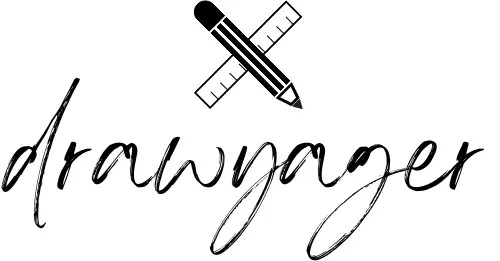Armed with a sketchbook and a variety of pencils within reach, the art of pencil sketching unveils a broad spectrum for your artistic pursuits. It’s often found that the simplest tools expose the most profound complexities within artwork. From the subtle shading that infuses life into a portrait to the bold strokes defining a landscape, the humble pencil asserts itself as a powerful means for conveying creativity.

My journey with pencil drawings began with mere doodles and evolved into complex scenes and intricate patterns. It’s all about passion meeting practice. Each empty page in my sketchbook is a new opportunity to experiment with techniques, textures, and even storytelling. Embracing pencil drawing ideas has honed not only my hand skill but also my eye for the subtleties of shadow and light.
The beauty lies in the diversity of ideas that can transform into striking visuals on paper. These might include capturing the essence of everyday life or conjuring fantastical beasts that previously resided only in my imagination. Every pencil mark contributes to a larger picture that I might not have envisioned at the outset, teaching me that sometimes the most impactful art comes from simply starting with an idea and seeing where it leads.
Getting Started
Embarking on a journey of pencil drawing ideas requires more than just a spark of creativity. The physical touch of a pencil on paper brings those concepts to life. Before I start with the pencil drawing ideas, I will start with the basics. If you’re already proficient at drawing, you can skip this part.
Choosing the Right Materials

To create compelling pencil drawing ideas, choosing the right materials is essential. I prefer high-quality graphite pencils for my sketches, as they produce crisp, clean lines. Here’s a simple list to keep in mind:
- Graphite pencils: for versatile shading and line work
- Charcoal: for deep, rich blacks and a variety of textures
- Colored pencils: to add a pop of color to your creations
- Sketchbook: with paper that tolerates erasing and sketching without tearing
- Sharpeners and erasers: to maintain pencil tips and correct mistakes
For ink enthusiasts, a fine pen can offer a permanent, stark contrast to softer pencil lines and give a special touch to your pencil drawing ideas.
Understanding Pencil Grades
Grasping pencil grades is crucial for mastering different shades and textures. Pencils are labeled from hard (H) to soft (B), and here’s a quick guide:
- H pencils (hard): yield lighter lines, excellent for detailed work
- B pencils (soft): produce darker, more expressive lines
- HB: falls in the middle, suitable for general use
Remember, the higher the number before the ‘B’, the softer the pencil; conversely, the higher the number before the ‘H’, the harder the pencil.
Basic Drawing Techniques
Mastering a few basic drawing techniques can elevate your work from good to great pencil drawing ideas. Pay attention to:
- Line quality: Practice applying different levels of pressure to create a range of lines from delicate to bold.
- Shading: Learn to create gradients, from light to dark, to add dimension.
- Texture: Use varied strokes to mimic the textures you see in your references, whether smooth or rough.
- Composition: Plan your artwork’s layout to guide the viewer’s eye and make your piece more engaging.
Remember, practice makes progress, and each sketch hones your skills as an artist. Pencil drawing offers a world of possibilities, so let your creativity flow onto the blank canvas before you.
Fundamental Techniques
When I explore pencil drawing ideas, I find that understanding the fundamental techniques sets the stage for creating captivating art. Let’s dive into the essentials.
Mastering Lines and Shapes
I always begin with the basics: lines and simple shapes. A firm grasp of line drawing techniques supports the complexity that comes later in my work. Lines form the foundation of all pencil drawings, so I make sure to practice various line types – straight, curved, thick, and thin – to develop control and confidence.
- Straight Lines: Great for geometric shapes and structures.
- Curved Lines: Essential for organic forms and contouring.
Introduction to Shading and Texture
Shading and texture breathe life into my pencil drawing ideas, transforming flat images into dynamic ones with depth and dimension. I focus on mastering shading techniques like hatching, cross-hatching, and stippling to create an array of textures and details. With these techniques, I can mimic the real-world complexity in my artwork, from the softness of a petal to the roughness of bark.
- Hatching: I use closely placed parallel lines to build up the tone.
- Cross-Hatching: I add another set of lines over the first, creating a mesh for darker shades.
- Stippling: By dabbing the paper with my pencil point, I create texture with dots.
Practice Makes Perfect
I cannot overemphasize the importance of regular practice. All the skills in the world won’t help without consistent practice to refine technique and add fluency to the work. Simple exercises that I repeat frequently include drawing shapes, practicing different types of lines, and experimenting with shading to enhance texture. Patience and perseverance are my companions on the journey to mastering pencil drawing ideas.
Drawing Subjects
When I think of pencil drawing ideas, my mind immediately wanders to the delicate interplay of graphite and paper. Let’s explore some specific subjects you can focus on to enhance your drawing skills and expand your creative repertoire.

Capturing Nature and Landscapes
Nature offers an abundance of scenes – from the grandeur of landscapes to the intricacies of a single leaf. In my pencil drawing ideas, I strive to capture the essence of these scenes, whether it’s the rolling contours of hills or the stark lines of a cliff face. A landscape can convey mood, time of day, and weather, making it a deeply expressive choice for pencil drawing.

- Mountain Range at Sunrise: Capture the majestic beauty of a mountain range bathed in the warm glow of the rising sun. Pay attention to the contours of the mountains, the play of light and shadow, and the soft colors of the sky.
- Coastal Cliffside: Draw a rugged coastal cliffside overlooking the ocean. Include crashing waves, rocky outcrops, and dramatic cliffs that stretch into the distance.
- Forest Clearing: Create a peaceful forest clearing with sunlight filtering through the canopy of trees. Add details like ferns, wildflowers, and dappled shadows to enhance the natural ambiance.
- Desert Landscape: Sketch a vast desert landscape with rolling dunes, sparse vegetation, and distant mountains on the horizon. Capture the sense of openness and solitude that characterizes desert environments.
- Rural Countryside: Draw a quaint rural countryside scene with winding country roads, fields of crops, and rustic farmhouses nestled among rolling hills. Incorporate elements like fences, barns, and grazing animals to add charm and character to the landscape.
- River Valley: Illustrate a tranquil river valley with lush greenery, meandering streams, and towering cliffs. Pay attention to reflections in the water and the interplay of light and shadow along the riverbanks.
- Frozen Winter Lake: Capture the serene beauty of a frozen winter lake surrounded by snow-covered trees and ice-covered shores. Include details like ice fishing huts, snow-capped mountains, and distant cabins to evoke the quiet stillness of winter.
- Tropical Island Paradise: Draw a tropical island paradise with palm trees, white sandy beaches, and crystal-clear turquoise waters. Add details like colorful coral reefs, tropical fish, and sailboats on the horizon to create a sense of paradise.
- Urban Cityscape: Sketch a bustling urban cityscape with towering skyscrapers, busy streets, and bustling city life. Capture the energy and dynamism of the city, with details like traffic, pedestrians, and iconic landmarks.
- Misty Forest: Create a mysterious misty forest scene with tall trees shrouded in fog. Use subtle shading and blending techniques to convey the ethereal quality of the mist and the depth of the forest.
Exploring Portraiture as Pencil Drawing Ideas
Portraiture is about more than capturing a likeness; it’s about revealing a character. I often focus on the eyes, as they carry emotion, or the turn of a mouth which can speak volumes. With pencil, the subtlety of shading and texture can bring a portrait to life, and it teaches me the discipline of observation. With regular practice, you will create great art from your pencil drawing ideas.

- Self-Portrait: Challenge yourself to create a self-portrait using a mirror. Explore different expressions and angles to capture your likeness and personality on paper.
- Family Portrait: Draw a portrait of your family members gathered together. Capture the unique characteristics and relationships between each person in the portrait.
- Elderly Wisdom: Create a portrait of an elderly person, focusing on capturing the wisdom, experience, and character etched into their face through lines and wrinkles.
- Childhood Innocence: Draw a portrait of a child, capturing their innocence, wonder, and curiosity through expressive eyes and playful features.
- Celebrity Portrait: Choose a celebrity or public figure you admire and draw their portrait. Pay attention to capturing their likeness and unique features, as well as their personality and aura.
- Historical Figure: Select a historical figure and draw its portrait, researching its appearance and personality traits to bring it to life on paper.
- Character Study: Draw a portrait of a fictional character from literature, movies, or mythology. Explore their personality, backstory, and emotional depth through facial expression and body language.
- Cultural Diversity: Create a series of portraits featuring people from diverse cultural backgrounds. Explore different ethnicities, traditions, and expressions of identity through portraiture.
- Emotional Expression: Experiment with capturing a range of emotions in portrait drawings. Pencil drawing ideas portraits that convey happiness, sadness, anger, surprise, and other complex emotions through facial expressions and body language.
- Environmental Portrait: Draw a portrait of a person in their natural environment, such as their workplace, home, or favorite outdoor setting. Explore the relationship between the person and their surroundings, capturing their sense of belonging and identity.
Each portrait presents a unique opportunity to delve into the nuances of human expression, character, and identity.
Drawing Animals and Birds
The animal kingdom provides a dynamic range of pencil drawing ideas. I find that capturing the fur of a squirrel or the feathers of a bird is a delightful challenge, requiring me to pay close attention to texture and movement. Each animal and bird brings its unique energy to a composition.

- Majestic Lion: Capture the regal presence of a lion with its mane flowing and a powerful gaze.
- Gentle Elephant: Draw an elephant in a serene pose, showcasing its wrinkled skin and expressive eyes.
- Graceful Deer: Illustrate a deer in a natural setting, conveying its elegance and sensitivity.
- Colorful Peacock: Sketch a peacock displaying its vibrant feathers in a majestic fan.
- Curious Rabbit: Capture the innocence and curiosity of a rabbit with its twitching nose and attentive ears.
- Majestic Eagle: Draw an eagle in flight, showcasing its impressive wingspan and keen eyesight.
- Playful Dolphin: Illustrate a dolphin leaping out of the water, capturing its playful spirit and gracefulness.
- Regal Horse: Sketch a horse in motion, showcasing its muscular build and flowing mane.
- Enigmatic Owl: Capture the wisdom and mystery of an owl with its piercing eyes and intricate feathers.
- Colorful Butterfly: Draw a butterfly in intricate detail, showcasing its delicate wings and vibrant patterns.
Botanical Drawing
Botanical subjects are endlessly fascinating to me. The lush detail in a single flower or the complex pattern of leaves on a tree makes for absorbing studies. When I draw these from my pencil drawing ideas, I emphasize individual textures and organic shapes, which sharpens both my focus and my pencil.

- Exotic Orchids: Capture the intricate details and elegant shapes of exotic orchid flowers, highlighting their delicate petals and intricate patterns.
- Majestic Sunflowers: Draw a cluster of sunflowers standing tall, capturing their large, vibrant blooms and textured foliage.
- Lush Ferns: Illustrate a dense forest floor carpeted with lush ferns, showcasing their intricate fronds and graceful arching stems.
- Blooming Roses: Sketch a bouquet of blooming roses, capturing the soft curves of their petals and the subtle variations in color and form.
- Botanical Illustration: Create a detailed botanical illustration of a specific plant species, focusing on accurately depicting its leaves, stems, flowers, and other botanical features.
- Tropical Palm Trees: Draw a tropical scene with swaying palm trees, capturing the unique shapes of their fronds and the texture of their bark.
- Vibrant Tulips: Illustrate a vibrant display of tulips in full bloom, showcasing their distinctive cup-shaped flowers and bold, bright colors.
- Succulent Garden: Sketch a collection of succulents arranged in a garden bed or potted containers, highlighting their unique shapes, textures, and patterns.
- Botanical Studies: Create a series of botanical studies focusing on different plant parts, such as leaves, flowers, fruits, and seeds, exploring their forms and structures in detail.
- Wildflowers in the Meadow: Capture the beauty of wildflowers blooming in a meadow, showcasing a variety of species in different stages of growth and bloom.
Creative Expression
When I explore pencil drawing ideas, I find that they’re an excellent avenue to express creativity and translate imagination onto paper. Now, let’s delve deeper into different styles that can add unique flavor to your artistic portfolio.
Abstract and Conceptual Ideas
Abstract concepts allow for an exploration of shapes and textures, often diverging from realistic representation to convey emotions or ideas. I like to think about how the interplay of shadow and light can create depth, making the abstract forms pulse with life on the canvas.
Comic and Character Design
Designing a character for a comic book involves understanding anatomy but also exaggerating features to express personality. It’s fascinating to give a character form, capturing their essence through bold lines and perspective that tells a story without a single word. Also, it’s very important to add a fitting landscape or a background, that adds a good and final touch to the pencil drawing ideas.

- Dynamic Superhero Poses: Sketch dynamic poses of superheroes in action, emphasizing exaggerated proportions and dramatic perspectives to convey a sense of power and movement.
- Whimsical Cartoon Characters: Create whimsical cartoon characters with exaggerated features and playful expressions, exploring unique shapes and forms to evoke humor and personality.
- Futuristic Sci-Fi Landscapes: Draw futuristic sci-fi landscapes with towering skyscrapers, sleek hovercraft, and other high-tech elements, exploring abstract shapes and geometric patterns to convey a sense of advanced technology and innovation.
- Surreal Creature Creations: Design surreal creatures with fantastical features and imaginative forms, combining elements from different animals, plants, and mythical creatures to create visually striking and otherworldly beings.
- Abstract Comic Panels: Experiment with abstract compositions and unconventional panel layouts to create dynamic comic panels that challenge traditional storytelling conventions and engage viewers in new and unexpected ways.
- Expressive Facial Expressions: Focus on capturing expressive facial expressions and emotions in your character designs, using exaggerated gestures and stylized features to convey a wide range of moods and personalities.
- Dynamic Action Sequences: Illustrate dynamic action sequences featuring your favorite comic book characters engaged in epic battles, daring rescues, or thrilling adventures, using dynamic poses and dynamic lines to convey movement and energy in you pencil drawing ideas.
- Character Transformations: Explore the concept of character transformations by depicting your characters undergoing dramatic changes in appearance, abilities, or personality, using abstract visual cues to convey the transformative process.
- Abstract Backgrounds and Environments: Experiment with abstract backgrounds and environments that set the stage for your comic narratives, using bold shapes, vibrant colors, and textured patterns to create immersive and visually captivating settings.
- Character Mash-Ups: Combine elements from different comic book characters or genres to create unique character mash-ups that blend familiar archetypes and tropes in unexpected and imaginative ways, exploring the boundaries of comic book storytelling and character design.
Still Life Drawing
In still life, common items become the stars. The way I draw a simple object like an apple involves careful consideration of light, shadow, and texture to bring a sense of realism. Here, perspective is essential to create a believable space where objects reside. If you want more inspiration on still life drawing, you can continue reading 50+ Colored Pencil Drawing Ideas, 75+ Themes to Draw, or 40+ Charcoal Drawing Ideas if you want to use charcoal.

- Fruit Bowl: Create an abstract composition featuring a fruit bowl, focusing on the shapes, textures, and negative spaces formed by the arrangement of fruits.
- Kitchen Utensil: Draw an abstract still-life scene featuring kitchen utensils such as spoons, forks, and knives, exploring their geometric forms and spatial relationships.
- Vintage Clock Study: Sketch an abstract interpretation of a vintage clock, emphasizing its intricate details, mechanisms, and ornate designs to create a clock, just like in your pencil drawing ideas.
- Abstract Floral Arrangement: Capture the essence of a floral arrangement in abstract form, focusing on the shapes, lines, and patterns created by the petals, stems, and leaves.
- Bookshelf Abstraction: Create an abstract depiction of a bookshelf, exploring the interplay of books, objects, and empty spaces within the composition.
- Teapot and Cups Study: Draw an abstract still-life scene featuring a teapot and cups, exploring the curves, angles, and reflections of the objects in pencil.
- Candle and Holder Abstraction: Sketch an abstract interpretation of a candle and holder, focusing on the play of light and shadow, as well as the geometric forms of the objects.
- Abstract Table Setting: Create an abstract representation of a table setting, focusing on the arrangement of plates, utensils, and glassware in dynamic compositions.
- Musical Instruments Study: Draw abstract representations of musical instruments such as guitars, violins, and trumpets, exploring their shapes, textures, and iconic features.
- Abstract Vase and Flowers: Capture the beauty of a vase and flowers in abstract form, exploring the organic shapes, flowing lines, and vibrant colors of the floral arrangement.
Architectural Sketches
The precision in architecture pencil drawing ideas, whether it be intricate cityscape details or the sweeping lines of a bridge, all comes down to understanding perspective and depth. For me, this discipline is about capturing the essence of structure and form, illustrating the complexities of our built environment.

- City Skyline: Create an abstract interpretation of a city skyline, focusing on the shapes, lines, and negative spaces formed by the buildings and structures.
- Futuristic Cityscape Study: Sketch an abstract representation of a futuristic cityscape, exploring geometric shapes, angular forms, and dynamic compositions.
- Abstract Building Facades: Draw abstract sketches of building facades, emphasizing patterns, textures, and architectural details such as windows, doors, and balconies.
- Urban Street Scene: Capture the energy and atmosphere of an urban street scene in abstract form, focusing on the interplay of light and shadow, as well as the movement of people and vehicles.
- Architectural Elements Study: Explore abstract representations of architectural elements such as arches, columns, and domes, using pencil to convey their structural integrity and aesthetic beauty.
- Interior Spaces: Create abstract sketches of interior spaces, focusing on the spatial relationships, perspectives, and atmospheric qualities of rooms, corridors, and atriums.
- Bridge Design: Sketch abstract designs for bridges, exploring innovative forms, structural concepts, and visual compositions that challenge conventional ideas of bridge architecture.
- Abstract Landscape Architecture: Draw abstract representations of landscape architecture features such as parks, gardens, and plazas, exploring the interaction between built structures and natural environments.
- Abstract Urban Infrastructure: Explore abstract interpretations of urban infrastructure such as highways, bridges, and tunnels, focusing on the rhythm, flow, and connectivity of these elements within the urban landscape.
- Architectural Abstraction of Historical Buildings: Create abstract sketches of historical buildings and landmarks, using pencil to capture the essence of their architectural styles, historical significance, and cultural heritage.
Advanced Drawing Challenges
When I dive into advanced pencil drawing ideas, I challenge myself on several fronts: pushing realism to new heights, mastering light and shadow, and grasping the intricate details of anatomy and proportions.
Realistic Pencil Drawing Ideas
For artists passionate about realism, the subtleties in realistic drawings are a nuanced challenge. Achieving a high level of detail demands a thorough understanding of texture, especially when rendering surfaces like hair or fabric. Key to this process is the use of varied pencils—from the soft B grades to the harder H grades—for different textures and depths.

- Hyperrealistic Portraits: Challenge yourself to create hyperrealistic portraits of people, focusing on capturing intricate details such as skin texture, hair strands, and facial features with precision and accuracy.
- Still Life with Reflections: Draw a complex still-life arrangement with reflective surfaces such as glassware, metal objects, or polished surfaces. Focus on accurately rendering reflections and highlights to create a sense of realism.
- Animal Anatomy Study: Study the anatomy of animals or humans and challenge yourself to create realistic drawings of various species, paying close attention to bone structure, muscle definition, and fur or skin texture. For humans, you can read my article about Muscle Drawing References.
- Landscape with Atmospheric Perspective: Create a landscape drawing that incorporates atmospheric perspective to convey depth and distance. Experiment with techniques such as diminishing scale, muted colors, and soft edges to create a sense of spatial depth.
- Architectural Rendering: Draw a detailed architectural rendering of a building or urban landscape, focusing on accurately depicting perspective, proportions, and intricate architectural details with realism and precision.
- Portrait in Charcoal: Challenge yourself to create a realistic portrait using charcoal, exploring the medium’s expressive potential to capture subtle gradations of light and shadow, as well as fine details of the human face.
- Wildlife in Natural Habitat: Draw wildlife in their natural habitats, capturing their behavior, movement, and interaction with the environment in your pencil drawing ideas. Focus on conveying the unique characteristics and personalities of each animal species with realism and authenticity.
- Botanical Illustration: Create highly detailed botanical illustrations of plants, flowers, or botanical specimens, focusing on accurately rendering intricate botanical details such as leaf veins, petal textures, and botanical structures.
- Portrait Drawing from Life: Challenge yourself to draw a portrait from life, working directly with a live model to capture their likeness, expression, and personality with realism and sensitivity to nuances of light and shadow.
- Realistic Figure Drawing: Draw realistic human figures in various poses and gestures, focusing on capturing the anatomy, proportions, and movement of the human body with accuracy and dynamism.
Experimenting with Light and Shadow
The interplay between light and shadows is pivotal in giving pencil drawing ideas their three-dimensional effect. I use sharp contrasts for dramatic scenes and softer shades for gentler moments.

- High Contrast Still Life: Set up a still life arrangement with objects that create strong contrasts between light and shadow. Focus on accurately rendering the interplay of light and shadow to create dramatic effects and emphasize the three-dimensional form of the objects.
- Nocturnal Scene: Draw a nocturnal scene illuminated by moonlight or artificial light sources. Experiment with capturing the subtle nuances of light and shadow in low-light conditions, focusing on creating a sense of atmosphere and mood.
- Backlit Portrait: Challenge yourself to draw a portrait with a strong backlighting effect. Explore how light interacts with the subject’s silhouette, hair, and features, and experiment with techniques to convey depth and dimensionality.
- Interior with Natural Light: Draw an interior space illuminated by natural light streaming through windows or skylights. Pay close attention to the way light filters through the space, casting shadows and creating highlights on surfaces and objects within the room.
- Sunset or Sunrise Landscape: Capture the beauty of a sunset or sunrise landscape, focusing on the dynamic interplay of light and shadow as the sun rises or sets as pencil drawing ideas. Experiment with capturing the warm hues of golden hour and the dramatic contrast between light and shadow in the landscape.
- Candlelit Scene: Draw a scene illuminated by candlelight, focusing on the warm, flickering glow of the candles and the intricate patterns of light and shadow they cast on surrounding objects and surfaces.
- Glass and Reflections: Challenge yourself to draw transparent or reflective surfaces such as glass, water, or mirrors. Experiment with capturing the distortions, reflections, and refractions of light as they interact with these surfaces.
- Street Scene at Night: Draw a nighttime street scene illuminated by streetlights, neon signs, and headlights. Explore the contrast between light and shadow in the urban environment, capturing the play of light on architecture, vehicles, and figures.
- Interior with Artificial Lighting: Create a drawing of an interior space illuminated by artificial lighting sources such as lamps, overhead lights, or spotlights. Experiment with different types of artificial lighting and their effects on the mood and atmosphere of the space.
- Underwater Scene: Draw an underwater scene illuminated by dappled sunlight filtering through the surface of the water. Explore how light behaves underwater, casting patterns of light and shadow on aquatic life and the ocean floor.
Understanding Anatomy and Proportions
If you’re an advanced artist, you will often be judged by your skill to handle on anatomy and proportions. Well, it’s not important what other people think about your ability to create anatomically correct pencil drawing ideas, but if you need some inspiration, I got you covered:
- Figure Drawing from Life: Attend a figure drawing session or work with a live model to practice capturing the human form in various poses. Focus on understanding the proportions of the body, including the placement of joints, muscle groups, and skeletal structure.
- Skeleton Study: Draw a detailed study of the human skeleton from different angles and perspectives. Pay attention to the proportions and relationships between different bones, and explore how the skeleton forms the underlying structure of the human body.
- Muscle Anatomy: Study the anatomy of major muscle groups in the human body and create detailed drawings that depict their origin, insertion, and action. Experiment with shading and highlighting to emphasize the three-dimensional form of muscles.
- Proportional Analysis: Analyze the proportions of the human body using measurement techniques such as comparative measuring and the use of anatomical landmarks. Draw studies that break down the body into simplified shapes and proportions to better understand its overall structure.
- Gestural Sketching: Practice gestural sketching to capture the dynamic movement and rhythm of the human figure. Focus on quick, fluid lines that convey the gesture and energy of the pose, while also considering the underlying anatomy and proportions.
- Foreshortening Studies: Explore the challenges of foreshortening by drawing figures in dynamic poses with exaggerated perspectives. Experiment with techniques to convey the illusion of depth and dimensionality while maintaining accurate proportions.
- Hand and Foot Studies: Focus on studying the anatomy and proportions of hands and feet in detail. Draw studies that break down the complex forms of hands and feet into simpler shapes, paying attention to the structure of bones, joints, and muscles.
- Facial Anatomy: Study the anatomy of the face and head, including the proportions of features such as eyes, nose, mouth, and ears. Draw detailed studies that explore the underlying bone structure and muscles of the face, as well as variations in facial expressions.
- Clothed Figure Drawing: Practice drawing figures in different types of clothing to understand how fabric drapes and conforms to the body. Pay attention to how clothing affects the perception of proportions and gestures in the figure.
- Master Copy Studies: Study the works of master artists who excelled in figure drawing and anatomy, such as Leonardo da Vinci, Michelangelo, or Albrecht Dürer. Analyze their techniques and approaches to figure drawing and anatomy, and create studies that emulate their style and mastery.
If you’re struggling with anatomy and looking for references, you can look at my drawing reference category.
Projects and Practice
Exploring pencil drawing ideas can be both refreshing and challenging. I often find that working on focused projects and consistent practice unlocks levels of creativity and skill that doodling alone doesn’t achieve.
Creating a Themed Sketchbook Series
I love dedicating entire sketchbooks to a theme of pencil drawing ideas. It’s like telling a story through sketches, where each page builds on the last. Choosing a theme related to a personal interest or something I haven’t tried before keeps me invested. Here’s how I get started:
- Select a Theme: This could be anything from nature, or architecture, to different species of birds – the key is picking something that will keep me inspired over time.
- Plan the Layout: Do I want a consistent layout or will each page be unique? Deciding this early helps me maintain a cohesive look.
- Start Sketching: Begin with light, rough outlines and gradually build up to more detailed layers.
Tip: To prevent smudging in my sketchbook, I often place a sheet of clean paper under my hand while I edit the finer details.
Participating in Drawing Challenges
Joining drawing challenges can be a fantastic way for me to push my boundaries and commit to regular practice. Here are a few steps to participate effectively:
- Choose a Challenge: Pick a challenge that fits your schedule and skill level. Some are daily, while others may be weekly.
- Set Aside Time: Carving out a regular time slot for your pencil drawing ideas practice helps to keep me on track.
- Share My Progress: May post your sketches online. Feedback from the community can be incredibly valuable and motivating.
Tip: When life gets busy, even a quick 5-minute doodle is better than skipping a day. It keeps the momentum going! Keep the pencil drawing ideas flowing!
By integrating these structured projects into your routine, you’ll see a discernible improvement in your pencil sketching skills. It’s all about finding that blend of practice, patience, and a bit of structured play with your pencils.
For a lot more inspiration, you can take a look at 75+ Themes to Draw, 40+ Charcoal Drawing Ideas, 50+ Colored Pencil Drawing Ideas, or at all of my other drawing ideas.
Frequently Asked Questions
Exploring various pencil drawing ideas can kickstart your creativity and help you develop your skills.
What are some easy and beautiful pencil drawing ideas for beginners?
For beginners, simple subjects like fruits, flowers, and everyday objects can be beautiful yet easy to start with. Starting with these can help in understanding shapes and shades without being overwhelming.
Can you suggest step-by-step guides to help improve pencil drawing skills?
Yes, beginners can benefit from guides that cover fundamentals such as creating outlines, shading, and adding texture. Following a structured approach helps in gradual improvement and building confidence.
What are some creative pencil drawing ideas for nature themes?
Nature offers endless inspiration for creative pencil drawings. Ideas include sketching landscapes, trees, leaves, or animals like squirrels or wolves.
How can adults find inspiration for pencil drawings that are simple yet elegant?
Adults can find inspiration in everyday elegance such as a ballet pointe shoe, a simple teacup, or an architectural element. These subjects can be depicted with clean lines and subtle shading for a sophisticated look.
What techniques can be used to create realistic drawings with pencil?
Achieving realism in pencil drawing ideas requires mastering techniques like accurate proportion measurement, varied shading for depth, and fine detailing. Utilizing a full range of pencil grades from light H to dark B pencils is also key.
Could you share some adorable and cute pencil drawing ideas perfect for a quick sketch?
Certainly! Sketching something adorable can be both enjoyable and a great way to practice. Quick sketch ideas include baby animals, cartoon characters, or small doodles of nature elements like flowers that have an endearing quality.
If you liked this blog post about Pencil Drawing Ideas, don’t forget to leave me a comment down below to tell me about your experience with it.







Your pencil art is truly captivating! The intricate details and lifelike quality you achieve make each piece come alive. I’m in awe of your talent.